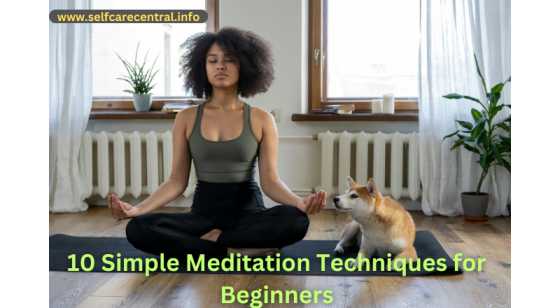1. Understanding Meditation Basics
1.1. What is meditation?
Meditation is a practice that involves focusing your mind to achieve a state of calm and clarity. It’s like giving your brain a mini-vacation from the constant chatter of thoughts. As someone who was once skeptical about meditation, I can tell you that it’s not about emptying your mind completely – it’s more about observing your thoughts without getting caught up in them.
1.2. Benefits of regular practice
Regular meditation can bring about some pretty amazing changes in your life. From my personal experience, I’ve noticed improved focus, better sleep, and a general sense of well-being. Scientific studies back this up, showing that meditation can reduce stress, anxiety, and even physical pain. It’s like a daily dose of mental vitamins!
1.3. Creating a suitable environment
Creating a meditation-friendly space doesn’t have to be complicated. I started with just a comfy cushion in a quiet corner of my bedroom. The key is to find a spot where you won’t be disturbed. Some people like to add candles or plants, but it’s really about what makes you feel calm and focused.
2. Mindful Breathing
2.1. Counting breaths technique
This technique is as simple as it sounds – you just count your breaths. I usually count up to ten and then start over. It’s a great way to anchor your attention and prevent your mind from wandering off to your to-do list or what’s for dinner.
2.2. Observing natural breath
With this method, you simply pay attention to your breath without trying to change it. Notice how the air feels as it enters and leaves your nostrils, or how your chest and belly move as you breathe. It’s like becoming a curious observer of your own breathing process.
2.3. Deep belly breathing
Deep belly breathing, or diaphragmatic breathing, involves breathing deeply into your abdomen rather than shallowly into your chest. I find this technique particularly helpful when I’m feeling stressed or anxious. It’s like giving your body a signal to relax and unwind.
3. Body Scan Meditation
3.1. Progressive muscle relaxation
This technique involves tensing and then relaxing different muscle groups in your body. Start from your toes and work your way up to your head. It’s a great way to release physical tension you might not even realize you’re holding.
3.2. Tension and release method
Similar to progressive muscle relaxation, but instead of tensing muscles, you simply focus on each part of your body and mentally tell it to relax. I like to imagine a wave of relaxation flowing through my body from head to toe.
3.3. Awareness of body sensations
In this practice, you simply notice the sensations in your body without trying to change them. You might feel tingling, warmth, or even discomfort. The goal is to observe these sensations with curiosity rather than judgment.
4. Loving-Kindness Meditation
4.1. Cultivating self-compassion
This practice involves directing kind and loving thoughts towards yourself. It might feel a bit awkward at first (it certainly did for me!), but with practice, it can be a powerful tool for boosting self-esteem and inner peace.
4.2. Extending kindness to others
After directing loving-kindness to yourself, you can extend these thoughts to others – starting with loved ones and gradually expanding to all beings. It’s like sending out good vibes to the world.
4.3. Developing a sense of interconnectedness
As you practice loving-kindness meditation, you might start to feel a greater sense of connection with others. I’ve found that this practice has helped me feel less isolated and more part of a larger community.
5. Guided Visualization
5.1. Nature imagery techniques
This involves imagining yourself in a peaceful natural setting. I like to visualize a quiet beach, but you could picture a forest, mountain, or any place that feels calming to you.
5.2. Safe place visualization
Similar to nature imagery, but this technique involves creating a mental “safe space” where you feel completely secure and at peace. It could be a real or imaginary place.
5.3. Goal-oriented visualization
This technique involves visualizing yourself achieving your goals. It’s like mental rehearsal for success. I’ve used this to prepare for presentations or challenging conversations.
6. Mantra Meditation
6.1. Choosing a meaningful mantra
A mantra is a word or phrase that you repeat during meditation. It could be something simple like “peace” or a longer phrase that resonates with you. The key is to choose something that feels meaningful to you personally.
6.2. Synchronizing mantra with breath
Try repeating your mantra in time with your breath. For example, you might think “peace” on the inhale and “calm” on the exhale. This helps to link the mantra with your physical state.
6.3. Silent vs. audible mantras
You can repeat your mantra silently in your mind or say it out loud. I prefer silent mantras, but some people find that speaking the words helps them stay focused. It’s worth trying both to see what works best for you.
7. Walking Meditation
7.1. Mindful steps in nature
Walking meditation doesn’t have to be done on a special path – you can practice it anywhere. When I’m out for a walk, I sometimes focus on the sensation of my feet touching the ground with each step. It’s a great way to bring mindfulness into everyday activities.
7.2. Indoor walking practice
You don’t need a lot of space for walking meditation. Even pacing back and forth in a room can work. The key is to walk slowly and mindfully, paying attention to each movement.
7.3. Coordinating breath with movement
Try synchronizing your breath with your steps. For example, you might take three steps with each inhale and three with each exhale. This creates a rhythm that can help keep you focused.
8. Mindful Eating Meditation
8.1. Engaging all five senses
Next time you eat, try to really pay attention to the experience. Notice the colors and textures of your food, the aromas, the flavors, and even the sounds as you eat. It’s amazing how much we usually miss when we eat on autopilot.
8.2. Appreciating food origins
Take a moment to consider where your food came from – the farmers who grew it, the people who transported and prepared it. This can help foster a sense of gratitude and connection.
8.3. Cultivating gratitude during meals
Before eating, take a moment to feel grateful for your food. This doesn’t have to be religious – it’s simply about acknowledging and appreciating the nourishment in front of you.
9. Sound Meditation
9.1. Using ambient sounds
Instead of trying to block out sounds during meditation, you can use them as a focus. Pay attention to the sounds around you – birds chirping, cars passing, the hum of appliances. Notice how sounds come and go.
9.2. Guided sound baths
Sound baths use instruments like singing bowls or gongs to create soothing sounds. You can find recordings online if you don’t have access to live sound baths. I find these particularly relaxing before bed.
9.3. Creating personal sound anchors
You can create your own “sound anchor” to bring you back to a meditative state. This could be a particular piece of music or a recording of nature sounds that you associate with feeling calm and centered.
10. Contemplative Meditation
10.1. Reflection on daily experiences
At the end of each day, take some time to reflect on your experiences. What went well? What was challenging? This isn’t about judging, but simply observing and learning.
10.2. Exploring personal values
Contemplative meditation can be a great way to explore your personal values. What’s truly important to you? How do your actions align with these values?
10.3. Cultivating wisdom and insight
Over time, this practice can lead to deeper insights about yourself and the world around you. It’s like becoming your own wise counselor.
Summary
Meditation doesn’t have to be complicated or time-consuming. Even a few minutes a day can make a big difference. The key is to find techniques that resonate with you and to practice regularly. Remember, there’s no “perfect” way to meditate – it’s a personal journey of self-discovery.
Frequently Asked Questions
1. How long should I meditate as a beginner?
Start with just 5-10 minutes a day. It’s better to meditate for a short time consistently than to try for long sessions and get discouraged.
2. What time of day is best for meditation?
The best time is whenever you can consistently fit it into your schedule. Many people like to meditate first thing in the morning or just before bed, but find what works for you.
3. How do I know if I’m meditating correctly?
There’s no “correct” way to meditate. If you’re taking time to sit quietly and focus your mind, you’re meditating. It’s normal for your mind to wander – just gently bring it back to your focus when you notice this happening.
4. Can meditation help with anxiety and stress?
Yes, many people find meditation helpful for managing anxiety and stress. It can help you learn to observe your thoughts and feelings without getting caught up in them.
5. Do I need special equipment to start meditating?
Not at all! While some people like to use meditation cushions or apps, all you really need is a quiet place to sit comfortably.

